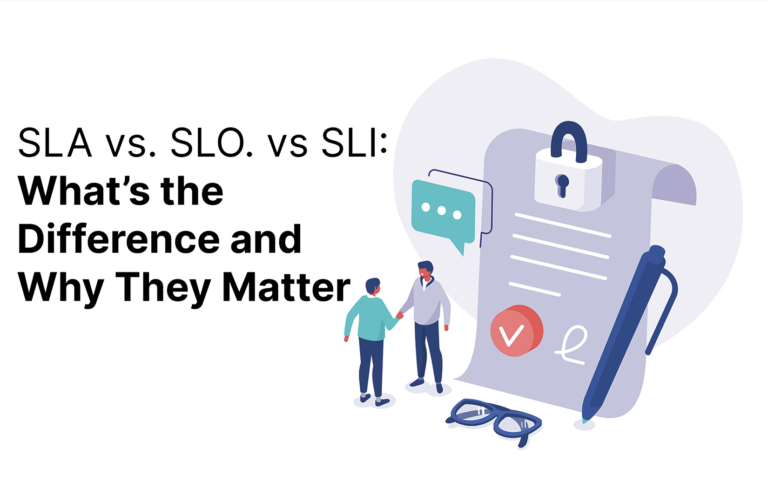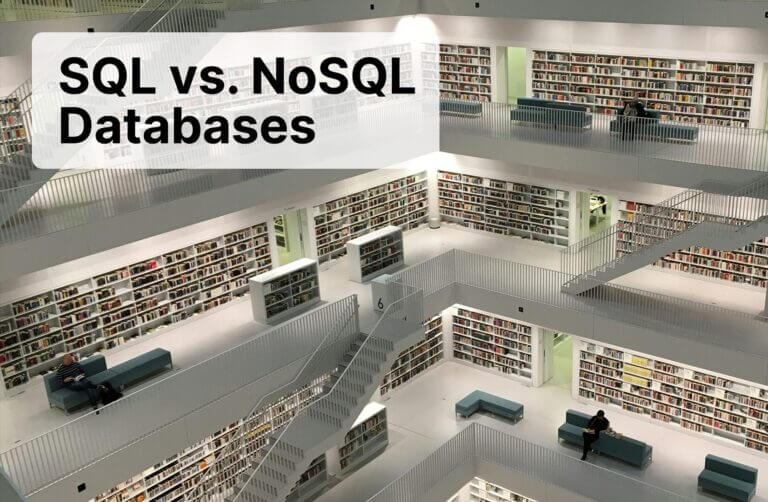When it comes to today’s digital solutions, customers expect a lot—in terms of performance, availability, usability, and more. That’s why most service providers have put a lot of thought into the standards of quality and customer experience they’re going to offer and develop SLAs, SLOs, and SLIs to help them maintain those standards. Here we are going to discuss SLA vs. SLO vs. SLI. These very important initialisms stand for:
- Service level agreements: The minimum levels of performance, availability, and other metrics that customers are guaranteed when using the provider’s solution
- Service level objectives: Internal goals that the provider wants to reach to meet those SLAs
- Service level indicators: Actual metrics that the provider uses to measure how close it is to meeting both SLOs and SLAs
All three concepts are a critical part of site reliability engineering (SRE), which is the process service providers use to set and monitor goals for system performance, reliability, and other factors.
Let’s take a closer look at each of these concepts.
What Are Service Level Agreements (SLAs)?
SLAs are what you promise your customers. They’re based on the assumption that no service is 100% available or reliable, no matter how much customers and service providers wish it was. So the questions become:
- How available are your systems going to be—what percentage can a customer rely on with absolute confidence?
- What will your team do if and when the system goes down?
- How quickly will issues be resolved?
- What kinds of guarantees can you give around speed or specific functionality of features?
This is the kind of information covered by SLAs. They form a type of contract between a provider and its customers to uphold predefined and agreed-upon standards around the performance, availability, and other facets of the service.
Another important part of an SLA is to draw up the consequences if those standards aren’t met at any point in time. These consequences could include rebates or refunds to the customer, free license extensions, or other financial penalties.
Best Practices for SLAs
- Keep technical teams involved in SLA creation. To create effective SLAs that satisfy customers and are realistic and achievable for your organization, make sure your technical team is involved in creating them. Oftentimes, SLAs are created by legal teams or business development executives who aren’t overseeing the daily operation and maintenance of the service, not to mention troubleshooting and issue resolution. IT and DevOps teams should be highly involved in creating SLAs to make sure they’re measurable and achievable and align with real business priorities.
- Create SLAs that reflect your customers’ preferences. SLAs should address customer expectations and focus on what matters most to them. While you might be excited about a certain performance feature of your service that customers might not even notice on their end, it shouldn’t be in an SLA.
- Keep SLAs simple and use clear language. Staying simple means staying high-level and tuned in to actual user functionality. If maintaining 99.5% system availability, for instance, is one of your SLAs, there’s no need to add detail around the dozen tasks and requirements that go into enabling that availability on the back end. Clear language is a must because when things go wrong, customers might take issue with points in the SLA that they didn’t completely understand up front.
What Are Service Level Objectives (SLOs)?
SLOs are the goals you need to reach to meet SLAs. These are specific objectives about things like response time, system availability, and solution performance. An SLA is the formal contract you create with your customer and SLOs are the individual standards or levels of quality, performance, and other factors that you’re promising to that customer.
SLOs are the “numbers” that customers can expect and that IT and DevOps teams can work toward. Often, SLOs are a bit more stringent than SLAs to give IT teams time to respond to issues before “breaking SLA.” For instance, an SLO might be 99.7% uptime, while the SLA promises 99.5%. If the system goes down, IT can rush to resolve the issue before breaking the agreement of 99.5% and being subject to penalties or other consequences.
Best Practices for SLOs
- Keep them simple and clear. It’s important that IT or your system engineers fully understand what is expected and how to achieve and maintain those standards.
- SLOs should account for possible issues. One problem with SLAs and SLOs alike is that they outline what the service provider will offer and don’t necessarily account for things like customer delays in reporting outages or other issues. If the SLA promises issue resolution within 24 hours, what happens if the customer doesn’t supply the needed information quickly enough? SLOs should have contingencies for these possibilities.
- SLOs for internal systems can be useful. Some organizations craft SLOs that address their internal networks or CRM or ERP systems, not just the customer-facing ones. This can help employees across the organization meet preset standards for customer service and more.
- Don’t create more than is necessary. While it’s important to create SLOs for the standards you’ve promised to customers, less can be more. Customer success and satisfaction doesn’t hang on every single metric. It’s okay to commit to only the most necessary SLOs so you can focus on meeting them.
What Are Service Level Indicators (SLIs)?
SLIs are the metrics that let you know how you’re doing with your SLOs and, ultimately, the SLA. For instance, if your SLA promises 99.5% uptime, your SLO will be 99.5% (or maybe a bit higher), and your SLI would be the actual measured uptime. To comply with any SLA, your SLIs must obviously meet or exceed the specified SLA numbers.
It’s important to track SLIs so you have a record to show customers that you’re meeting or exceeding the SLA terms. Tracking SLIs also gives you data to analyze and see when and why you’re not meeting SLOs and assess whether changes are needed to better manage systems.
Best Practices for SLIs
- Keep them simple. Don’t overcomplicate things by requiring IT to track things that don’t have a direct effect on meeting SLAs.
- SLIs need to be precise and measurable. The whole point of having SLIs is to clearly articulate what is being tracked and how a service measures itself. While staying simple, make sure the methodology for measuring or calculating each SLI is clear and explainable.
What SLAs Does Pure Storage Offer?
At Pure Storage, we understand that when it comes to SLAs, SLOs, and SLIs, the bottom line is setting standards that enable us to deliver delightful customer experiences. We offer SLAs around performance, uptime, zero data loss, buffer capacity, zero planned downtime, and no data migration. We’re also the first storage provider in the industry to offer an SLA for energy efficiency, which allows our customers to feel confident that we’re doing what we can to reduce our carbon footprint. In addition, with our ransomware recovery add-on service, customers are guaranteed a clean storage environment to recover to after an attack, including shipping of a clean array next business day and an onsite professional engineer.
Our SLAs are part of the reason we achieved a Net Promoter Score (NPS)—the industry gold standard for measuring customer experience—of 81.4 this year, which puts us in the top 1% of all B2B businesses tracked by Medallia. In general, an NPS above 50 is considered excellent. The average NPS for technology companies is 60. And we’ve achieved a score in the 80s for more than seven years running.
That’s because we’re committed to developing long-term, win-win relationships with our customers. We listen to your feedback to improve our processes and products and want to be the best partner we can be in enabling your success and future growth.
What SLIs Does Pure Storage Offer?
Pure Storage offers transparency in measuring ourselves on our SLAs with SLIs that customers can see in Pure1®. Customers can see exactly how each license is delivering on the SLAs, starting with SLIs for Performance and Energy Efficiency, and most customers get much better than our guarantees. No competitor matches the breadth or robustness of Evergreen//One SLAs; not only that, At Pure Storage we proactively monitor our commitments to hold ourselves accountable, and we are transparent with our customers about how we do it.
Ready to learn more?
Learn more about storage as a service by visiting our Evergreen//One™ subscription webpage.







